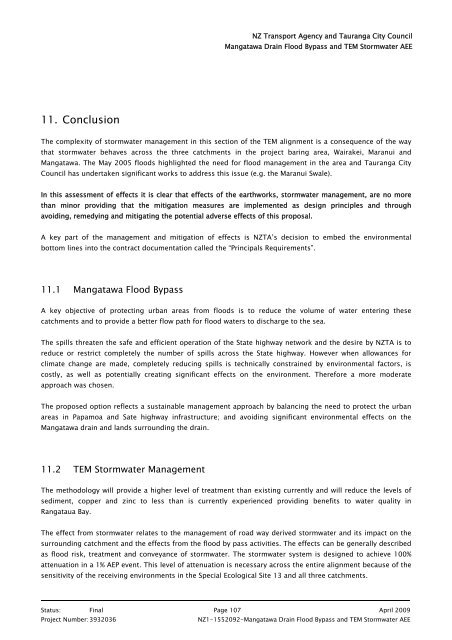2. Mangatawa catchment consents for earthworks, storm water ...
2. Mangatawa catchment consents for earthworks, storm water ...
2. Mangatawa catchment consents for earthworks, storm water ...
- No tags were found...
Create successful ePaper yourself
Turn your PDF publications into a flip-book with our unique Google optimized e-Paper software.
NZ Transport Agency and Tauranga City Council<br />
<strong>Mangatawa</strong> Drain Flood Bypass and TEM Storm<strong>water</strong> AEE<br />
11. Conclusion<br />
The complexity of <strong>storm</strong><strong>water</strong> management in this section of the TEM alignment is a consequence of the way<br />
that <strong>storm</strong><strong>water</strong> behaves across the three <strong>catchment</strong>s in the project baring area, Wairakei, Maranui and<br />
<strong>Mangatawa</strong>. The May 2005 floods highlighted the need <strong>for</strong> flood management in the area and Tauranga City<br />
Council has undertaken significant works to address this issue (e.g. the Maranui Swale).<br />
In this assessment of effects it is clear that effects of the <strong>earthworks</strong>, <strong>storm</strong><strong>water</strong> management, are no more<br />
than minor providing that the mitigation measures are implemented as design principles and through<br />
avoiding, remedying and mitigating the potential adverse effects of this proposal.<br />
A key part of the management and mitigation of effects is NZTA’s decision to embed the environmental<br />
bottom lines into the contract documentation called the “Principals Requirements”.<br />
11.1 <strong>Mangatawa</strong> Flood Bypass<br />
A key objective of protecting urban areas from floods is to reduce the volume of <strong>water</strong> entering these<br />
<strong>catchment</strong>s and to provide a better flow path <strong>for</strong> flood <strong>water</strong>s to discharge to the sea.<br />
The spills threaten the safe and efficient operation of the State highway network and the desire by NZTA is to<br />
reduce or restrict completely the number of spills across the State highway. However when allowances <strong>for</strong><br />
climate change are made, completely reducing spills is technically constrained by environmental factors, is<br />
costly, as well as potentially creating significant effects on the environment. There<strong>for</strong>e a more moderate<br />
approach was chosen.<br />
The proposed option reflects a sustainable management approach by balancing the need to protect the urban<br />
areas in Papamoa and Sate highway infrastructure; and avoiding significant environmental effects on the<br />
<strong>Mangatawa</strong> drain and lands surrounding the drain.<br />
11.2 TEM Storm<strong>water</strong> Management<br />
The methodology will provide a higher level of treatment than existing currently and will reduce the levels of<br />
sediment, copper and zinc to less than is currently experienced providing benefits to <strong>water</strong> quality in<br />
Rangataua Bay.<br />
The effect from <strong>storm</strong><strong>water</strong> relates to the management of road way derived <strong>storm</strong><strong>water</strong> and its impact on the<br />
surrounding <strong>catchment</strong> and the effects from the flood by pass activities. The effects can be generally described<br />
as flood risk, treatment and conveyance of <strong>storm</strong><strong>water</strong>. The <strong>storm</strong><strong>water</strong> system is designed to achieve 100%<br />
attenuation in a 1% AEP event. This level of attenuation is necessary across the entire alignment because of the<br />
sensitivity of the receiving environments in the Special Ecological Site 13 and all three <strong>catchment</strong>s.<br />
Status: Final Page 107 April 2009<br />
Project Number: 3932036<br />
NZ1-1552092-<strong>Mangatawa</strong> Drain Flood Bypass and TEM Storm<strong>water</strong> AEE
















